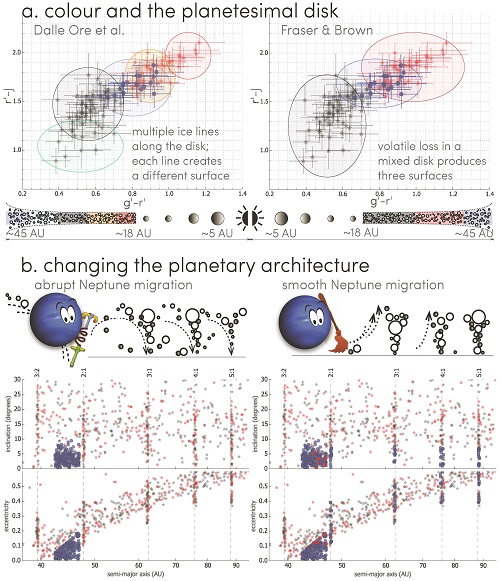Principal Investigator: Wesley Fraser, Queen's University Belfast
Program Summary:
The surfaces of trans-Neptunian objects (TNOs) have for a long time been poorly understood. Other than the large objects which exhibit signatures of various ices, astronomers have been able to discern very little about the compositional makeup of most TNOs. In recent years, some concrete knowledge about the distribution of surface colours of small TNOs has come to light. It is now generally accepted that small TNOs fall into at least three classes of object based on their surface colours and albedo. TNO surface type is also highly correlated with dynamical class, with certain types of TNO only being found in certain regions of the outer Solar System. For example, the so-called cold classical objects are both uniquely red and dynamically cold, while more dynamically excited objects such as the Plutinos - of which Pluto is a member - exhibit a bimodal distribution of surface colours from almost entirely neutral reflectors to some of the reddest objects in the Solar System. This colour-dynamical correlation presents the intriguing idea that the surfaces of TNOs contain information on more than composition, but as well hold the key to understanding the dynamical processes that lead to the giant planets violently dispersing the protoplanetesimal disk and populating the Kuiper Belt region. It is around this idea that the COL-OSSOS survey is designed. Using nearly 400 hours GMOS and NIRI observations on Gemini-North, over the next 4 years this program will observe optical and NIR Colours of all targets in the Outer Solar System Origins Survey (OSSOS) brighter than r’=23.5. The focus of the survey is completeness and consistency, with the same SNR=25 being reached in all bands, for all targets brighter than our depth limit.
This survey will, for the first time, provide a combined compositional-dynamical test to answer key questions about the Outer Solar System’s cosmogony. For example, was Neptune’s motion from its primordial formation location to its current locale violent and ‘jumpy’, or smooth? By mapping the fraction of objects with cold-classical like surface colours throughout the Trans-Neptunian region, we will be able to determine how much of the belt was populated by dynamical scattering, a signature of violent motion, versus sweep-up, a signature of smooth motion as Neptune passed through and dispersed the protoplanetesimal disk. As another example, we will be able to determine if the primordial disk was compositionally homogenous, or heterogeneously structured with many ice lines throughout its extent. The surfaces of TNOs must reflect that structure; a heterogeneous disk will result in a clumpy colour distribution with many unique types, while a homogeneous disk will result in a smooth distribution of colours with only a few distinct types. The legacy of COL-OSSOS is a large TNO dynamical and colour database of roughly 140 TNOs with fully understood observational biases from discovery to compositional characterization.

Co-Investigators:
- Michele Bannister, University of Victoria
- JJ Kavelaars, Herzberg Institute of Astrophysics
- Rosemary Pike, University of Victoria
- Susan Benecchi, Planetary Science Institute
- Scott Tremaine, Institute for Advanced Study
- Megan Schwamb, Academia Sinica
- Alex Parker, UC Berkeley (Astronomy)
- Nuno Peixinho, Unidad de Astronomia, U. de Antofagasta
- Audrey Delsanti, Laboratoire d'Astrophysique de Marseille
- Aurelie Guilbert-Lepourte, European Space Agency
- Matthew Lehner, Academia Sinica
- Michael Marsset, European Souther Observatory
- Audrey Thirouin, Instituto de Astrofisica de Andalucia
- Pierre Vernazza, Laboratoire d'Astrophysique de Marseille
- Shiang-Yu Wang, Academia Sinica